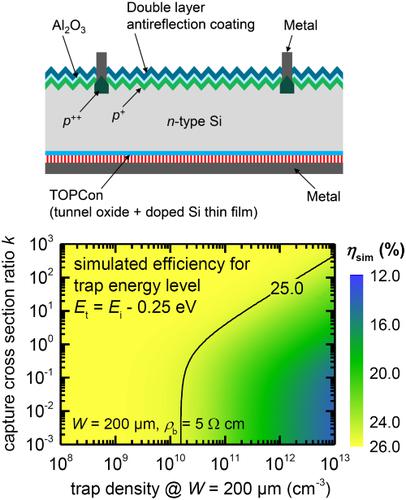当前位置:
X-MOL 学术
›
Prog. Photovoltaics
›
论文详情
Our official English website, www.x-mol.net, welcomes your
feedback! (Note: you will need to create a separate account there.)
Impact of bulk impurity contamination on the performance of high‐efficiency n‐type silicon solar cells
Progress in Photovoltaics ( IF 8.0 ) Pub Date : 2018-01-23 , DOI: 10.1002/pip.2990 Armin Richter 1 , Jan Benick 1 , Andreas Fell 1 , Martin Hermle 1 , Stefan W. Glunz 1, 2
Progress in Photovoltaics ( IF 8.0 ) Pub Date : 2018-01-23 , DOI: 10.1002/pip.2990 Armin Richter 1 , Jan Benick 1 , Andreas Fell 1 , Martin Hermle 1 , Stefan W. Glunz 1, 2
Affiliation

|
The experimental variation of wafer thickness and resistivity at device level combined with a comprehensive device simulation study allows the identification of dominating recombination‐induced power loss mechanisms in high‐efficiency n‐type silicon solar cells (A. Richter et al, Sol. Energy Mater. Sol. Cells 173, p. 96, 2017). Under the assumption of specific Shockley‐Read‐Hall (SRH) recombination parameters, impurity recombination within the silicon bulk was identified as one main source for efficiency losses particularly for solar cells made of high‐resistivity silicon. In this work, we extend that analysis approach focusing on the SRH recombination parameters in order to investigate whether certain properties of these recombination‐active impurities can be identified using this kind of simulation‐based analysis. Reported SRH recombination parameters of various common impurities (eg, Fe, Cr, or Ni) were considered. It was found that a dominating role of certain impurities as Cu, Au, Co, or Zn can be excluded. A general simulation study as a function of the fundamental SRH recombination parameters allowed us to reduce the possible SRH parameters significantly in particular of the capture cross‐section ratio of electrons and holes. These results demonstrate that our analysis approach, which combines an experimental variation of wafer thickness and resistivity with a comprehensive device simulation, can provide deep insights into the solar cells loss mechanisms. In particular, the conclusions regarding SRH recombination are of importance for solar cells made of n‐type silicon as there are no meta‐stable impurity states formed that would allow a direct identification of impurity recombination–related power loss as reported for p‐type Si.
中文翻译:

大量杂质污染对高效n型硅太阳能电池性能的影响
在器件级的晶片厚度和电阻率的实验变化与全面的器件仿真研究相结合,可以识别出在高效率n型硅太阳能电池(A.Richter等人,Sol.Energy Mater.Sol.Cells 173,p.96,2017)。在特定的Shockley-Read-Hall(SRH)重组参数的假设下,硅块内的杂质重组被认为是效率损失的一个主要来源,特别是对于由高电阻率硅制成的太阳能电池而言。在这项工作中,我们扩展了侧重于SRH重组参数的分析方法,以调查是否可以使用这种基于模拟的分析来识别这些重组活性杂质的某些性质。考虑了报告的各种常见杂质(例如,Fe,Cr或Ni)的SRH重组参数。发现可以排除某些杂质如Cu,Au,Co或Zn的主导作用。根据基本SRH重组参数的函数进行的一般模拟研究使我们可以显着降低可能的SRH参数,尤其是电子和空穴的捕获截面积比。这些结果表明,我们的分析方法将晶片厚度和电阻率的实验变化与全面的器件仿真相结合,可以深入了解太阳能电池的损耗机理。特别是,有关SRH重组的结论对于由以下材料制成的太阳能电池非常重要 将晶圆厚度和电阻率的实验变化与全面的器件仿真相结合,可以深入了解太阳能电池的损耗机理。特别是,有关SRH重组的结论对于由以下材料制成的太阳能电池非常重要 将晶圆厚度和电阻率的实验变化与全面的器件仿真相结合,可以深入了解太阳能电池的损耗机理。特别是,有关SRH重组的结论对于由以下材料制成的太阳能电池非常重要n型硅,因为没有形成亚稳态的杂质态,因此可以直接识别与p型Si报道的与杂质复合有关的功率损耗。
更新日期:2018-01-23
中文翻译:

大量杂质污染对高效n型硅太阳能电池性能的影响
在器件级的晶片厚度和电阻率的实验变化与全面的器件仿真研究相结合,可以识别出在高效率n型硅太阳能电池(A.Richter等人,Sol.Energy Mater.Sol.Cells 173,p.96,2017)。在特定的Shockley-Read-Hall(SRH)重组参数的假设下,硅块内的杂质重组被认为是效率损失的一个主要来源,特别是对于由高电阻率硅制成的太阳能电池而言。在这项工作中,我们扩展了侧重于SRH重组参数的分析方法,以调查是否可以使用这种基于模拟的分析来识别这些重组活性杂质的某些性质。考虑了报告的各种常见杂质(例如,Fe,Cr或Ni)的SRH重组参数。发现可以排除某些杂质如Cu,Au,Co或Zn的主导作用。根据基本SRH重组参数的函数进行的一般模拟研究使我们可以显着降低可能的SRH参数,尤其是电子和空穴的捕获截面积比。这些结果表明,我们的分析方法将晶片厚度和电阻率的实验变化与全面的器件仿真相结合,可以深入了解太阳能电池的损耗机理。特别是,有关SRH重组的结论对于由以下材料制成的太阳能电池非常重要 将晶圆厚度和电阻率的实验变化与全面的器件仿真相结合,可以深入了解太阳能电池的损耗机理。特别是,有关SRH重组的结论对于由以下材料制成的太阳能电池非常重要 将晶圆厚度和电阻率的实验变化与全面的器件仿真相结合,可以深入了解太阳能电池的损耗机理。特别是,有关SRH重组的结论对于由以下材料制成的太阳能电池非常重要n型硅,因为没有形成亚稳态的杂质态,因此可以直接识别与p型Si报道的与杂质复合有关的功率损耗。











































 京公网安备 11010802027423号
京公网安备 11010802027423号